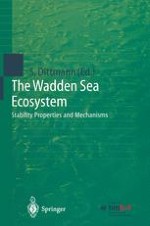1999 | OriginalPaper | Chapter
Recolonization of Tidal Flats After Disturbance
Authors : Sabine Dittmann, Carmen-Pia Günther, Ulrike Schleier
Published in: The Wadden Sea Ecosystem
Publisher: Springer Berlin Heidelberg
Included in: Professional Book Archive
Activate our intelligent search to find suitable subject content or patents.
Select sections of text to find matching patents with Artificial Intelligence. powered by
Select sections of text to find additional relevant content using AI-assisted search. powered by
The benthic recolonization of experimentally disturbed sandflat sites by diatoms, nematodes and small macrofauna was studied with several treatments, differing in intensity and timing of disturbance. Furthermore, recolonization following a natural disturbance, the ice winter 1995/96, was studied and compared with the results of the experiments.Diatoms were the fastest organisms recolonizing the disturbed sites. Within a few days, their species number, species composition and individual abundances were comparable to control situations. This colonization pattern depended on the diatoms available in the ambient sediment at the time of disturbance. The mode of recolonization was passive via sediment transport. The ice winter had little effect on the diatoms and abundances were comparable to preceding years. Yet, three species, which had not been recorded in the Wadden Sea before, occurred in the tidal flats in 1996.Nematodes reached ambient densities in the experimentally disturbed plots within a few weeks or months, with a slower recolonization the longer the disturbance had lasted. After the ice winter, nematode abundances increased steadily and reached even higher values in summer 1996 than in the years before.Smaller sized macrofauna recolonized disturbed experimental plots in spring faster than plots disturbed in autumn. The recolonization was also faster, the shorter the disturbance had lasted. The first stages of recolonization reflected the ambient situation of the species composition and abundance of benthic organisms. After several months, species numbers, abundance and community composition in the disturbed plots could not be distinguished from the reference plots. The first macrofaunal species colonizing the experimentally disturbed plots were the polychaete Pygospio elegans, Ostracoda and the amphipod Urothoe poseidonis. These were also dominant in the benthic community in 1996 after the ice winter. Juvenile polychaetes colonized the experimental sites to a higher degree than the ambient sediment. The course of the recolonization was mainly dependent on the availability of settling organisms, i.e. larvae as well as postlarvae. The study period was not long enough to record all successional stages.
